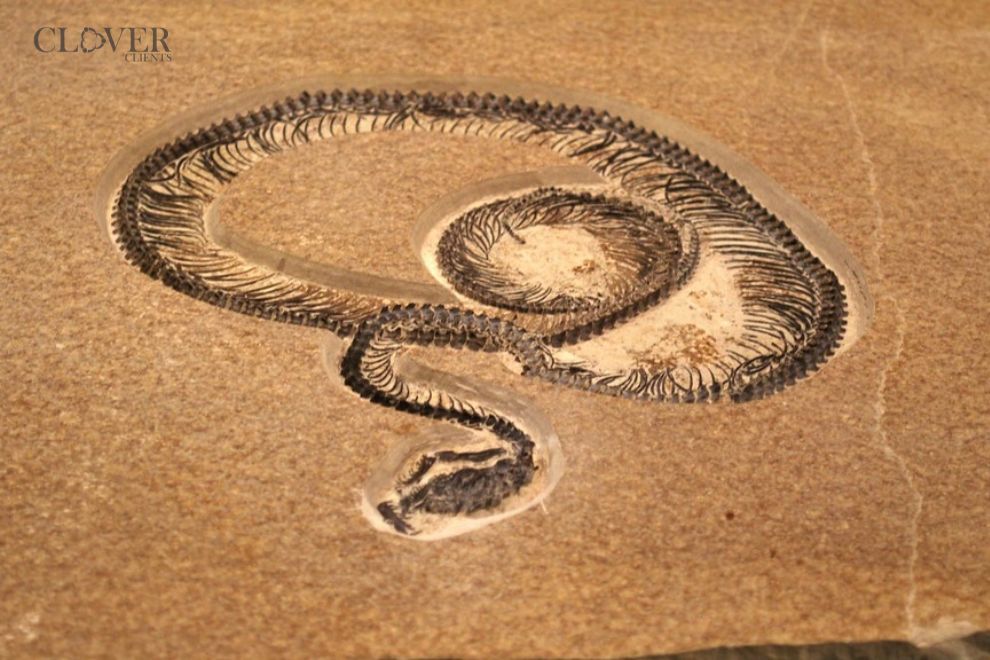Vasuki is an extinct genus of madtsoiidae snake from the Middle Eocene Naredi Formation of India. This genus contains a single species, V. indicus, known from several vertebrae. The snake’s body length is estimated to be between 10.9–15.2 meters (36–50 feet). This makes Vasuki the largest known madtsoiidae and potentially the longest snake ever discovered.
A Groundbreaking Discovery
In 2024, Vasuki indicus was described as a new genus and species of madtsoiidae snake based on fossil remains. The generic name, Vasuki, references the divine serpent from Hindu mythology. The specific name, indicus, references India, the country where Vasuki fossils were found.
Vasuki indicus is the name given to 47 million-year-old, 15-meter-long fossilized vertebrae. The remains of the longest snake that ever lived were found in a Gujarat coal mine in 2004. Over years of study and research, scientists concluded in 2024 that it is a new genus and species of madtsoiidae snake. This lineage is a relic that originated in India.
The Mythological Connection
In Hindu mythology, Vasuki is the divine serpent coiled around the neck of Shiva. Moved by his devotion, Shiva chose to wear Vasuki as an ornament. Vasuki’s brother Sheshnag coils himself into the shape of a bed on which Vishnu reclines, protected by a hood canopy. When devas and asuras planned to churn the ocean of milk to obtain Amrit, the elixir, Vasuki let them use him as the rope. Wound around the Mandara mountain, with devas holding onto one end and asuras the other, Samudra Manthan – the churning of the ocean – became possible.
The serpent has varied portrayals in different cultures and mythologies. In some contexts, it is seen as good, while in others, as evil. In Biblical and other Abrahamic references, a serpent, believed to be Satan, tempted Eve to eat the forbidden apple in the Garden of Eden. This act unleashed suffering on Adam and Eve and their descendants, starting from their expulsion from their idyllic home.
The serpent is often seen as a protector and guardian. Many depictions of Gautam Buddha and Mahavir in meditative poses show them guarded by a snake. The snake forms a canopy with its hood to shelter them from the elements. Many temples have snake carvings as protectors of the treasures within.
Medical Symbolism
The World Health Organisation (WHO)’s symbol is a world map superimposed with a staff entwined by a snake. A staff with two snakes coiled around it is the symbol of nursing. Asclepius, the ancient god of healing, belonged to a cult where snakes figured as healing agents. He was so effective as a healer that it was feared he would render humans immortal. Therefore, Zeus got him killed. Hence, the snake is part of medical symbols, as an enabler of healing and new life. This belief also stems from the snake’s ritual of shedding its old skin and growing a new one, akin to a kind of rebirth.
Discovery of the Largest Snake
In a significant discovery, paleontologists in Gujarat unearthed remains of the world’s largest snake that once roamed the Earth. This massive predator dates back to ancient times and is comparable in size to the longest snake ever recorded. This enormous serpent, scientifically named Vasuki indicus, shares its name with the serpent Vasuki from Hindu mythology.
Discovery and Research
Professor Sunil Bajpai and Debajit Datta from IIT Roorkee made a significant discovery. They described finding 27 pieces of a “partial, well-preserved” vertebral column belonging to the snake. The researchers believe Vasuki indicus may have rivaled the size of the renowned Titanoboa.
Debajit Datta explained, “Vasuki was a majestic animal,” a postdoctoral researcher in paleontology at IIT-Roorkee and the lead author of the study. “It may well have been a gentle giant, resting its head on a high porch formed by coiling its massive body for most parts of the day or moving sluggishly through the swamp like an endless train.”
This giant serpent is thought to have been among the most formidable predators from the time of the dinosaurs’ extinction 65 million years ago to the emergence of Megalodon around 23 million years ago. Yet, the study’s authors concede uncertainties regarding their size estimations for Vasuki indicus.
Uncertainties and Estimations
While Vasuki indicus is estimated to be between 10.9 and 15.2 meters long, some uncertainties remain. These uncertainties are due to the incomplete fossil record and the limitations of current estimation methods.
The discovery of Vasuki indicus provides crucial insights into the evolution and diversity of snakes. This giant snake sheds light on the ecological dynamics of its era and the role of snakes as apex predators.
Future research will focus on uncovering more fossils and understanding the biology and behavior of Vasuki indicus. Detailed studies will help confirm the size estimates and provide more information about its habitat and lifestyle.
The discovery of Vasuki indicus, the largest known madtsoiid snake, is a significant milestone in paleontology. This majestic serpent not only adds to our understanding of prehistoric life but also connects deeply with cultural and mythological narratives. As scientists continue to unravel the mysteries of Vasuki, we gain a richer perspective on the history of life on Earth and the fascinating creatures that once roamed our planet.

